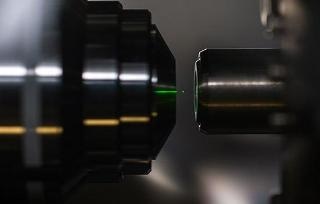Aug 10 2017
An innovative type of sensing technique has been developed by researchers at RIT. The technique involves capturing data at higher accuracy than it is probable at present, and it also assures the development of compact, inexpensive and light-weight sensors.
 It’s no trick of the eye; it’s an optical trap. Levitated optomechanics can make a nanoparticle float in space. A finely focused laser beam forms an “optical tweezer” and creates a tiny, isolated laboratory for the study of delicate quantum states. RIT scientist Mishkat Bhattacharya tests his theoretical predictions on such experimental platforms used by his collaborator Nick Vamivakas at the University of Rochester’s Institute of Optics. CREDIT: J. Adam Fenster and Prof. A. N. Vamivakas, University of Rochester.
It’s no trick of the eye; it’s an optical trap. Levitated optomechanics can make a nanoparticle float in space. A finely focused laser beam forms an “optical tweezer” and creates a tiny, isolated laboratory for the study of delicate quantum states. RIT scientist Mishkat Bhattacharya tests his theoretical predictions on such experimental platforms used by his collaborator Nick Vamivakas at the University of Rochester’s Institute of Optics. CREDIT: J. Adam Fenster and Prof. A. N. Vamivakas, University of Rochester.
Theoretical Physicist Mishkat Bhattacharya from RIT is looking into creating innovative and highly accurate quantum sensors for the U.S. Department of the Navy’s Office of Naval Research. A US$550,000 grant, which is an extension of an earlier grant, supports the 3 year study. As part of this study, Bhattacharya will investigate interactions between matter and light at the nanoscale and evaluate gravitational force and weak electromagnetic field measurements.
The U.S. National Nanotechnology Initiative has stated that custom-built microscopes evaluate theoretical predictions that offer a description of matter at the nanoscale, where 1 nm equals one-billionth of 1 m. The breadth of a strand of human hair is nearly 80,000-100,000 nm.
The research work of Bhattacharya centers on the growing physics field of levitated optomechanics—a field that analyzes nanoparticles by confining the particles inside a laser beam. Also called as “optical tweezers,” the technique of laser trapping involves investigating the constraints of quantum effects in isolation and eliminating physical disturbances from the neighboring environment.
Bhattacharya has adopted the laser trapping method to advance quantum mechanics a step forward by investigating quantum effects in the nanoparticles including many billions of atoms. He analyzes the point at which quantum mechanics, explaining the nature of microscopic particles, overlaps on classical physics, governing macroscopic particles. He further investigates the interaction between light and matter in macroscopic quantum physics.
“Levitated optomechanical systems provide a clean platform for studying quantum optics, information science, and precision measurement and sensing,” stated Bhattacharya, who is a member of the Future Photon Initiative as well as an Associate Professor in RIT’s School of Physics and Astronomy.
In order to analyze disparate nanosystems for the Office of Naval Research, Bhattacharya has singled out a nanodiamond inside a pocket of light. Upon being suspended in front of laser light, the particle is transformed into a floating probe. Bhattacharya is fascinated about the impressions found in the light and the details related to the gravitational forces and the electromagnetic fields acting upon the nanoparticle.
Bhattacharya has worked in cooperation with Pardeep Kumar, a Postdoctoral Associate and Wyatt Wetzel, an RIT Undergraduate Physics Major. Peter Mizes, a visiting undergraduate from Massachusetts Institute of Technology, has joined Bhattacharya’s Atomic, Molecular and Optical Physics Theory Group this summer. Bhattacharya investigates his theoretical hypotheses in the lab of Nick Vamivakas, an Experimental Physicist from the University of Rochester’s Institute of Optics as well as Bhattacharya’s colleague.
As part of his first study for the Office of Naval Research, Bhattacharya ascertained the smallest force that can be observed using a diamond crystal that levitates instead of spinning. The new study analyzes the end-products of three nanosystems, where each nanosystem included nanoparticles that are optically confined under disparate states:
- A particle including an impurity that functions either as a spin in response to magnetic fields or as an excess charge in response to electric fields.
- A particle moving in three dimensions similar to a pendulum.
- A particle with size greater than the wavelength of light entrapping it.
Quantum mechanics provides insights into the nanoscale realm and is controlled by distinctive physical laws.
Unique rules apply in quantum physics. It is not the day-to-day physical universe familiar to our experience.
Mishkat Bhattacharya, Theoretical Physicist, RIT
The field of optomechanics involves the investigation of interactions between light and very small nanoscale particles. Sensing techniques enhanced at the submicroscopic scale enables carrying out intricate measurements of physical characteristics that give a detailed account of various phenomena such as electric and magnetic fields, velocity, temperature, acceleration, force and gravitation.
In the future, quantum sensors may be used to observe gravitational waves, discover dark matter, perfect quantum computing and develop highly accurate accelerometers used for developing display screens that can be positioned at any angle, states Bhattacharya.